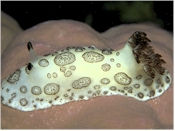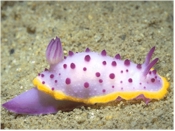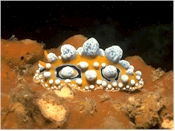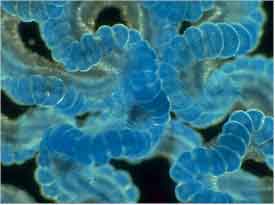|
Glaucus
The pelagic nudibranch Glaucus, in the process of eating Porpita, a modified single polyp Chondrophoran.
Biological Background Nudibranchs are members of the Phylum Mollusca, which also contains snails, slugs, bivalves (e.g. clams with a paired shell), and cephalopods (octopus, squids, cuttlefish and Nautilus). Nudibranchs are found in Sub-class Opisthobranchia, which contains the marine "slugs" with external gills and the shell reduced in size (bubble shells) or absent altogether (nudibranchs and sea-hares). Nearly all nudibranchs are benthic animals, which means they crawl around on the sea-floor. In common with most tropical marine taxa, nudibranchs have radiated into numerous species in the coral reef environment. Coral reef nudibranchs are predators with very particular food preferences, and each species may consume only 1 or 2 different prey items. However, considered as a group, they feed on a wide variety of sessile benthic animals, including sponges, bryozoans, ascidians, soft corals, gorgonians, and hydroids. Hint for photographers - to find a particular species of nudibranch, first you have to find its particular food source! Most of these prey organisms contain complex chemical compounds that are toxic to fish and other predators. However, nudibranchs have evolved novel metabolic processes that enable them to consume their prey without suffering adversely from chemical toxins. Many species store the toxins, and even entire nematocysts, in external protuberances on their own bodies. Thus, they in turn become unpalatable to fishes and other potential predators, and they advertise this unpalatability with bright warning colours.
This raises some interesting evolutionary questions.... Was the nudibranch ancestor a shelled animal that first developed resistance to prey toxins, and then lost it's shell which it no longer needed for predator defense? Is the evolution of resistance to a novel chemical toxin necessary for each new species of nudibranch to evolve into its own feeding niche?
The unusual Glaucus In nature, the animals that have evolved to be the exception to the general rule are often exceedingly interesting. Such an animal is Glaucus - where most other nudibranchs are benthic, Glaucus is pelagic. It has left the bottom, and lives out its whole life swimming upside down near the water surface with the other animals which collectively make up the neustonic community (the neuston is the surface & top 1-2 meters of the ocean). It still retains a fondness for toxic prey, feeding mainly on pelagic hydromedusae such as Porpita and Vellela, and it still incorporates the prey toxins into its body like other nudibranchs. However, the neustonic layer of the open ocean places its own constraints on the form and function of organisms that live there.
Physalia stinging zooids
If you have an article of general interest that you would like considered for the article of the month then we would love to hear from you. If you are also able to supply images then we can include those as well. You can email us at iq3d@imagequest3d.com |
||||||||
|
|
||||||||





